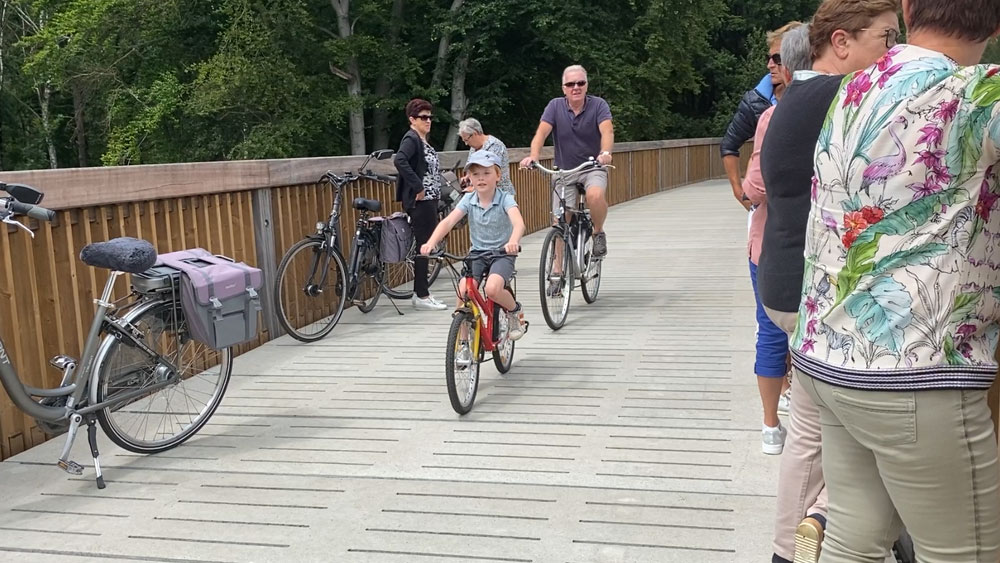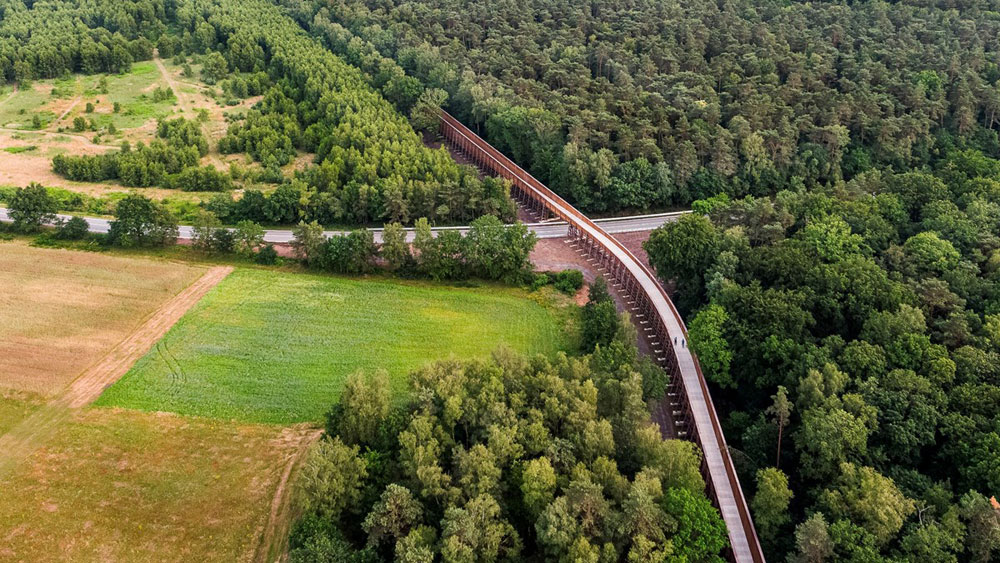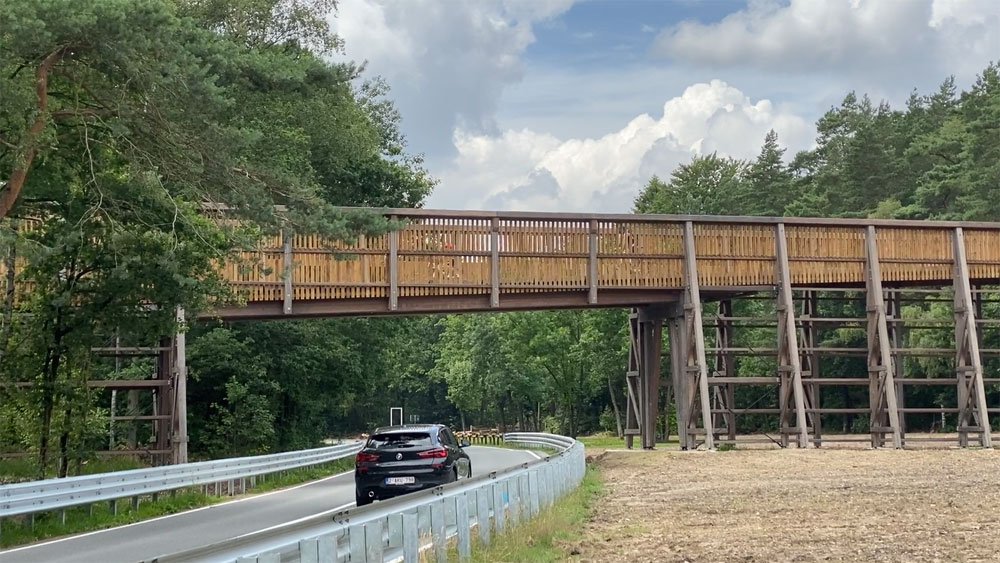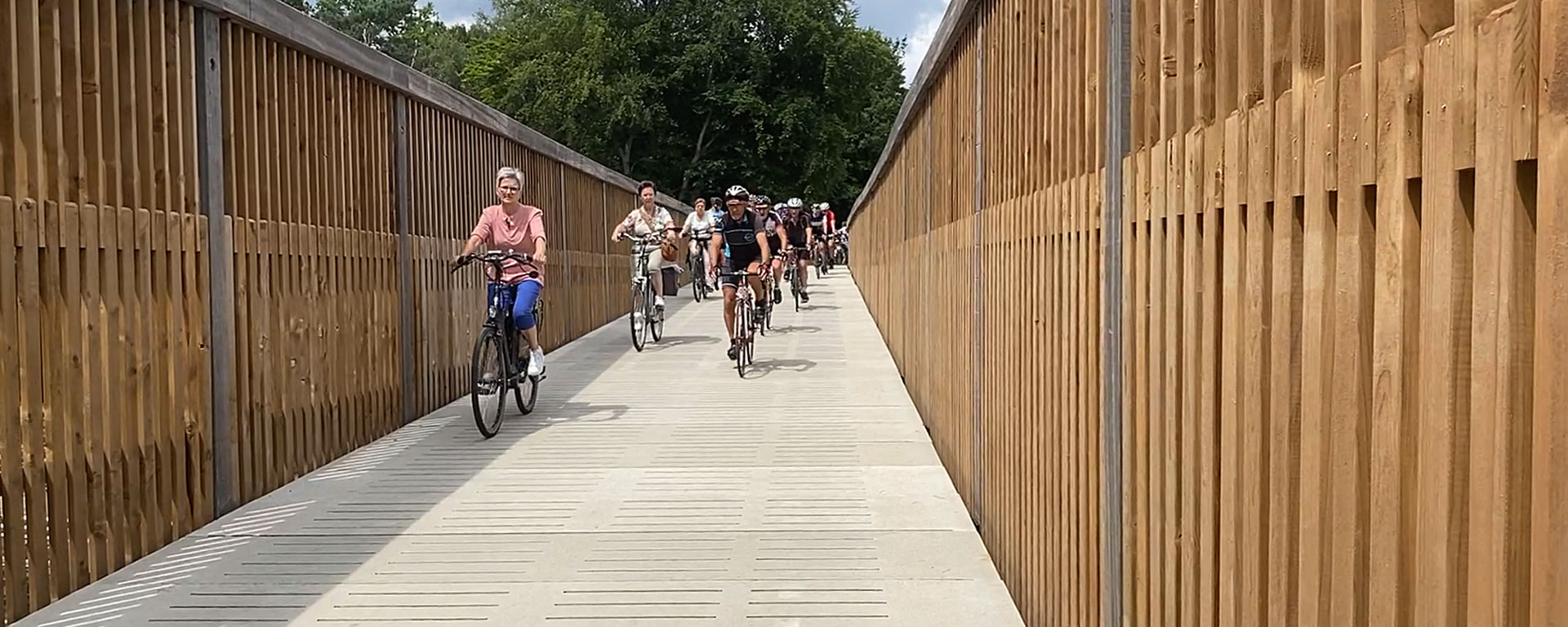The gigantic wooden walls look rather intimidating when you approach them in the woods near Maasmechelen in Belgium. The cycleway between the dark trees takes you to a concrete deck between two even darker walls of almost 7 metres tall. That deck rises slowly to the top of the walls making them less daunting with every metre you cycle. Once at the top, your very restricted view up until that point opens up and suddenly being able to see the vast heathland of “Hoge Kempen” National Park is a beautiful experience.


The tourist board “Visit Limburg” opened a third “cycling experience enhancement”. It is a 4 kilometre long cycle route called: “Cycling through the heathland” (in Dutch “Fietsen door de Heide” or #FDDH) in the middle of Flanders’ only national park “Hoge Kempen”. The top attraction in this ride is a 294m long and 6.7m tall wooden cycling viaduct with an exceptional guarding design. The other two projects have been around for a while. I showed you “Cycling through water” and “Cycling through the woods” in an earlier post. (In Dutch “Fietsen door het water” #FDHW and “Fietsen door de bomen” #FDDB respectively.). The opening of this third project was delayed for quite some time. Initially it would be finished late 2018, then it would be spring 2020, but in the end it became summer 2021.


The wooden viaduct was designed by MAAT-ontwerpers and Witteveen + Bos. Contractor Besix built the structure. The viaduct was opened on 5 July 2021, after a building period of a little over two 2 years.
The project was initiated by the tourism board. The total investment was 2.9m euro which was shared between the municipality of Maasmechelen, the province of Limburg and Toerisme Vlaanderen (Tourism Flanders). The opening itself was done by representatives of these three authorities. One of whom, provincial executive member Igor Philtjens, wrote on his own blog:
“With our cycling experiences, we want cyclists to enjoy our Limburg fauna and flora even more. As in the other experiences, this installation also blends into the surrounding nature. In this exceptional way, we bring cyclists into close contact with everything the National Park has to offer.”


Building had started in June 2019. The project was meant to become an iconic cycle viaduct straight through the heathland of the Hoge Kempen National Park which is on the tentative Unesco world heritage list. The bridge’s supportive structure is made of Azobé tropical hardwood, supplied by the same Dutch firm which also delivered the wood for Europe’s longest cycle bridge in Winschoten, the bridge in Oirschot and the viaduct in Harderwijk, all in the Netherlands.
The spindles in the guarding walls (the vertical boards) are made of pine wood. The pine trees were grown locally to be used in the coal mines as pit-props. After the mines had closed in the 1970s the pine trees had never been harvested. By using these local trees now for the viaduct it connects to the area’s mining history.


.The top of the side guard remains horizontal at the highest level from the beginning to the end of the entire viaduct. That means that you are cycling in between two impressive walls of wood on a gentle slope (4%) until you reach the top where the landscape opens up and the concrete deck stays horizontal for about 30 metres. That breath-taking view, after having been confined between the walls, is overwhelming and it results in almost everyone stopping on the spot. Unfortunately, no extra space was designed for people wanting to enjoy the view – much like in the other two projects – and that results in a busy and messy situation at the top. Especially since the deck is only 3.5 m wide. It is a pity this wasn’t considered after the experiences with the first two projects.

If you would like to visit this site, or one of the other two, the official website of the three projects is also available in English. At this site cars must be parked at the edge of the national park. You can rent bicycles near some of the parking places. That can also be done at the Railway station of Genk from where it is a 13km ride on the numbered junction network. The nearest railway station in the Netherlands is in Maastricht, at exactly 20km, which is where I cycled from. It was an easy ride but for one hill. I had not anticipated a 10% incline to reach this location. I filmed some excerpts of the ride to and from this new tourist attraction. You can find that video below the two of the viaduct.



What kind of material is used for surface of this wooden bridge?
A map would be very helpful …
Mark, you always leave me, after reading your post, and watching your videos, wanting to visit your wonderful country.
Thank you,
Keith
will it be painted rainbow?
Yes, in beautifull rainbow colours to tell homophobes to mind their own business what we do overhere in this part of the world.
Wow! It’s wonderful. Thank you 😊